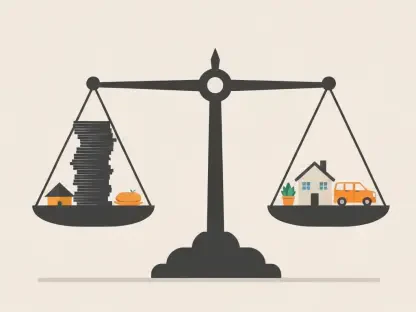The recent turmoil in equity markets caused by tariffs has significantly impacted consumer sentiment in the United States. A detailed analysis based on the Bain & Company/Dynata Consumer Health Indexes (CHI) reveals differing reactions among upper-income, middle-income, and lower-income consumers. These varying responses highlight the intricate dynamics at play within different economic strata and their potential implications for the broader US economy.
Upper-Income Consumer Outlook
Sharp Decline in Sentiment
Upper-income Americans have witnessed a dramatic fall in their consumer outlook due to market disruptions. The CHI reported an 11.8-point drop in April, marking the most substantial decline since the onset of the COVID-19 pandemic. This downturn can be primarily attributed to the upheavals in the stock markets, which have significantly impacted their investment portfolios. Given that upper-income individuals typically hold substantial portions of their wealth in stocks, these market disruptions have directly undermined their financial stability and overall confidence. The significant decrease in sentiment among this group is a clear indicator of their heightened sensitivity to equity market fluctuations.
The broader implications of this decline are noteworthy, as upper-income consumers play a critical role in the economic landscape due to their significant discretionary spending. The sharp reduction in their outlook could lead to a prolonged decrease in high-end consumer activity, affecting various sectors of the market that rely heavily on affluent consumers. The cascading effects of this sentiment drop could potentially slow down economic growth, as businesses catering to upper-income segments may experience reduced revenues and consequently, may reevaluate their investment and expansion plans.
Spending Intentions Rise
Interestingly, despite the overall decline in outlook, upper-income consumers’ spending intentions have shown an unexpected increase of 2.1 points. This paradoxical rise suggests a strategic behavioral shift where affluent consumers are attempting to front-run potential impacts from tariffs by accelerating their planned purchases. By doing so, they aim to avoid anticipated price hikes due to tariffs on imported goods and services, which could become more expensive in the future. This preemptive buying behavior reflects their desire to maintain lifestyle standards and mitigate the financial impact of increased costs in the long term.
This proactive approach underscores the complexity of consumer behavior among affluent individuals who have the financial flexibility to adapt to economic changes. While their general outlook may be pessimistic, their immediate spending decisions reveal an astute awareness of market dynamics and a strategic response to mitigate potential risks. However, if market instability persists, this temporary uplift in spending intentions may not be sustainable, leading to a potential contraction in discretionary spending in the longer term, further affecting overall economic growth.
Overall Consumer Outlook
Decline in Aggregate Outlook
The negative sentiment among upper-income consumers has led to a noticeable decrease in the overall CHI outlook reading for all US consumers. This reading fell by 5.3 points to 94.6 in April, reflecting widespread concern across different income groups. The aggregate decline signifies that the apprehensions of upper-income individuals have permeated through to the general populace, creating a broader sense of economic unease. This pervasive worry hints at deeper systemic issues that may be influencing consumer confidence, such as longstanding economic policies, global market uncertainties, and tariff-induced disruptions.
The repercussions of this aggregate decline cannot be understated, as consumer sentiment is a critical driver of economic activity. When consumers, particularly those in higher income brackets, display diminished confidence, it can lead to a reduction in overall consumer spending. This has a domino effect on various sectors, potentially slowing down economic growth across multiple industries, from retail to real estate. Consequently, businesses may scale back on investment and hiring, leading to a self-reinforcing cycle of economic sluggishness.
Economic Implications
The reduced outlook among upper-income consumers can have far-reaching economic consequences. Since this group accounts for more than half of discretionary spending in the US, prolonged negativity could slow down economic growth significantly. Discretionary spending, which includes non-essential items such as luxury goods, entertainment, and vacations, is highly sensitive to consumer confidence levels. When confidence wanes, this spending can swiftly decline, creating ripple effects throughout the economy. For instance, sectors that depend heavily on high-end consumer demand may witness a drop in sales, prompting measures such as cost-cutting or layoffs.
Furthermore, the broader economic repercussions extend to investor confidence, both within the US and globally. A sustained negative outlook among upper-income consumers can trigger cautious behavior among investors, who may perceive the sentiment as a bellwether of deeper economic instability. This can lead to reduced investments in the stock market and other financial systems, further exacerbating economic volatility. Therefore, understanding and addressing the factors contributing to this reduced outlook are imperative for policymakers and business leaders, as their actions can help restore confidence and stabilize economic growth trajectories.
Middle-Income Consumer Behavior
Neutral Perspective
Middle-income consumers have not experienced a drastic change in outlook, with only a slight 0.2-point decline. Their sentiment remains at a long-term neutral level, heavily tied to the housing market. This stability reflects the unique financial dynamics of middle-income individuals, whose wealth is often concentrated in home equity rather than volatile equities. Consequently, fluctuations in the stock market have a more muted impact on their overall financial health and consumer outlook. The steady outlook indicates a level-headed approach to economic uncertainties, underpinned by a cautious optimism regarding their financial future.
However, this neutral stance also highlights their vulnerability to disruptions in the housing market. Any significant downturn in real estate values could swiftly alter their consumer sentiment, potentially leading to declines in spending patterns and broader economic participation. Therefore, maintaining stability in the housing sector is critical for preserving the confidence and spending behavior of middle-income consumers.
Defensive Financial Moves
In response to ongoing economic uncertainties, middle-income consumers are adopting a more defensive financial stance. Their saving intentions have risen by 2.4 points, while debt usage intentions have dropped by 2.5 points. This behavior indicates a shift towards financial prudence, with individuals prioritizing savings over expenditure and seeking to reduce their reliance on credit. By increasing their savings, middle-income consumers aim to build financial buffers that can help them weather potential economic upheavals, such as job losses or unexpected expenses.
Reducing debt usage also reflects a cautious approach to personal finance, where individuals are wary of accumulating liabilities amidst potential economic instability. This trend towards fiscal conservatism is indicative of a broader strategy among middle-income consumers to safeguard their financial well-being in uncertain times. By focusing on savings and debt reduction, they position themselves to better handle future economic challenges, although this conservative stance may also limit their immediate contribution to consumer-driven economic growth.
Lower-Income Consumer Resilience
Continued Optimism
Lower-income consumers show resilience and minimal concern despite market disruptions. Their outlook readings have been on an upward trend for six months, thanks to the strong job market. The stability in their sentiment can be largely attributed to the relative security they find in consistent employment, which provides a steady source of income and a degree of financial predictability. This optimism is further bolstered by wage growth and employment opportunities that have remained robust amidst broader economic uncertainties.
Unlike their upper and middle-income counterparts, lower-income individuals are less exposed to the fluctuations of the stock market, thus insulating them from its immediate impacts. This group’s continued optimism underscores the importance of a stable job market in maintaining consumer confidence across all income levels. It also highlights their ability to maintain positive sentiment even in the face of broader economic turbulence, driven by their reliance on stable employment as a core component of financial security.
Mixed Economic Sensitivity
Despite their current resilience, lower-income consumers remain sensitive to changes in the broader economy, particularly in areas such as employment and wage growth. A downturn in the job market or stagnation in wages could quickly erode their optimism, leading to more cautious spending behaviors and a decline in consumer confidence. This group’s financial outlook is closely tied to their employment status, making them more vulnerable to economic policies and market conditions that impact job creation and wage levels. Therefore, sustaining employment growth and wage increases are critical to maintaining their positive sentiment and economic participation.
Continued optimism among lower-income consumers also relies on the broader economic environment, including factors such as affordable housing, healthcare, and access to education and training opportunities. Addressing these issues can further strengthen their financial stability and consumer sentiment, creating a more resilient and inclusive economy that benefits all income groups. By supporting policies that promote job growth and economic security, policymakers can help maintain the optimism and spending power of lower-income consumers, contributing to overall economic stability and growth.
Divergent Sentiment Across Income Groups
Market Turmoil Impact
The analysis underscores the significant impact of tariff-induced market turmoil, particularly on upper-income Americans. As their investment portfolios suffer, their financial health and confidence are undermined, leading to a sharp decline in their consumer outlook. This phenomenon highlights the interconnected nature of global trade policies and domestic consumer sentiment, illustrating how external economic forces can reverberate through different strata of society. The volatility triggered by tariffs has exposed the vulnerabilities of affluent individuals, whose wealth is intricately tied to global equity markets.
In contrast, middle-income consumers show a more stable, albeit cautious, outlook, primarily influenced by the housing market. Their defensive financial moves indicate a strategic response to economic uncertainties, focusing on savings and debt reduction as measures to safeguard their financial well-being. This cautious approach reflects their attempt to shield themselves from potential economic disruptions, prioritizing long-term financial stability over immediate consumption. Meanwhile, lower-income consumers maintain an optimistic outlook due to job market stability, underscoring the importance of employment in influencing consumer sentiment.
Consumer Behavior Patterns
The recent upheaval in equity markets, primarily due to tariff impositions, has noticeably affected consumer sentiment across the United States. An in-depth examination using the Bain & Company/Dynata Consumer Health Indexes (CHI) delineates distinct reactions among various income groups, including upper-income, middle-income, and lower-income consumers. The analysis underscores the complexity inherent in the economic behaviors and sentiment shifts within these diverse income strata. Each group’s unique response to market volatility provides valuable insight into how economic pressure points can have varying effects on different segments of the population. The overall implications of these varied consumer reactions are critical, as they offer a broader perspective on potential influences on the US economy. This multifaceted picture is essential for understanding not only immediate economic impacts but also long-term trends. The insights derived from this analysis could guide policy decisions and business strategies, making it a pivotal resource in navigating the current economic environment.









